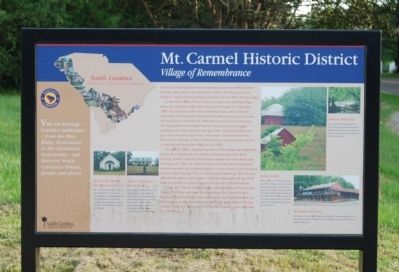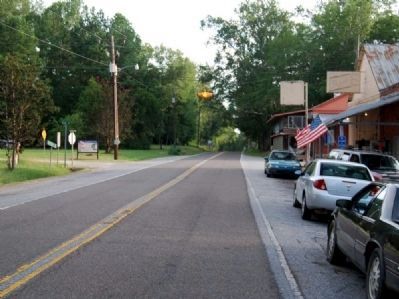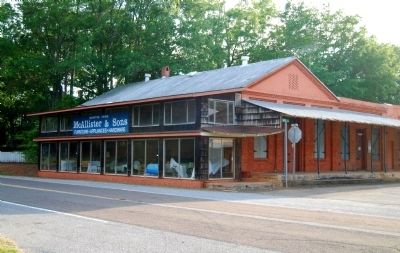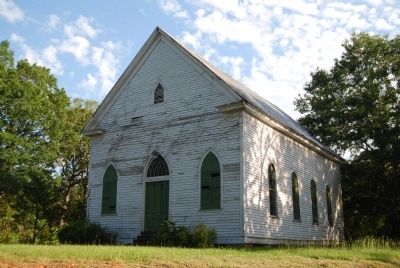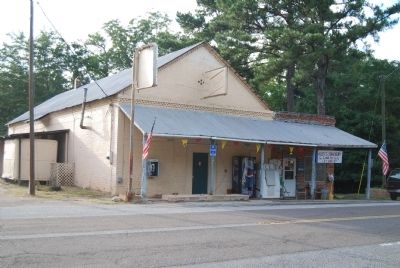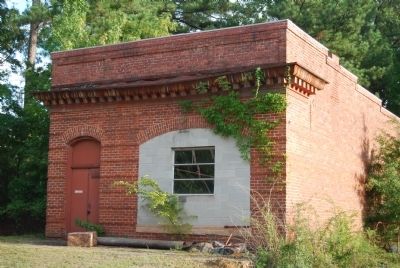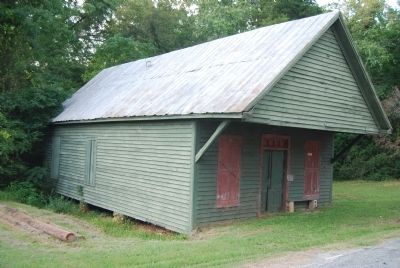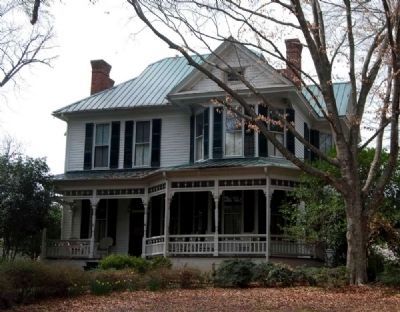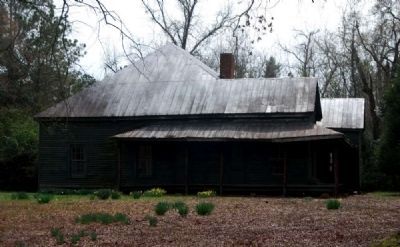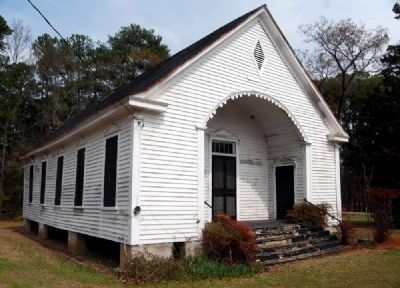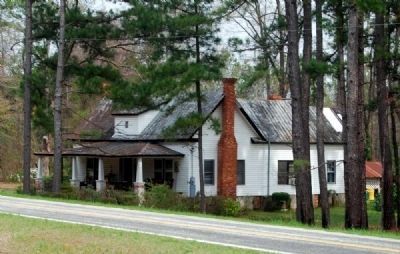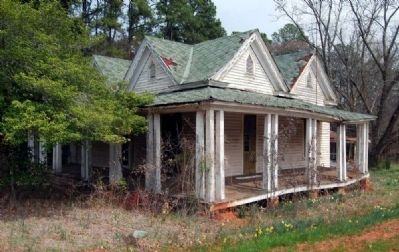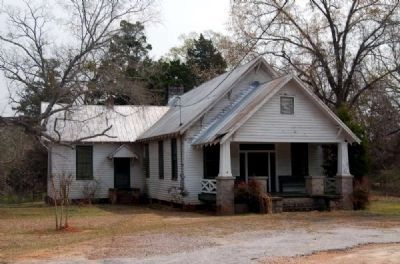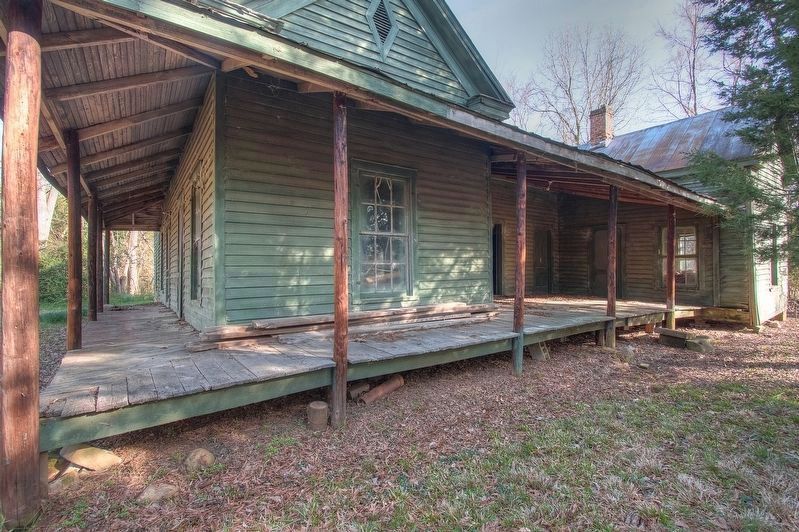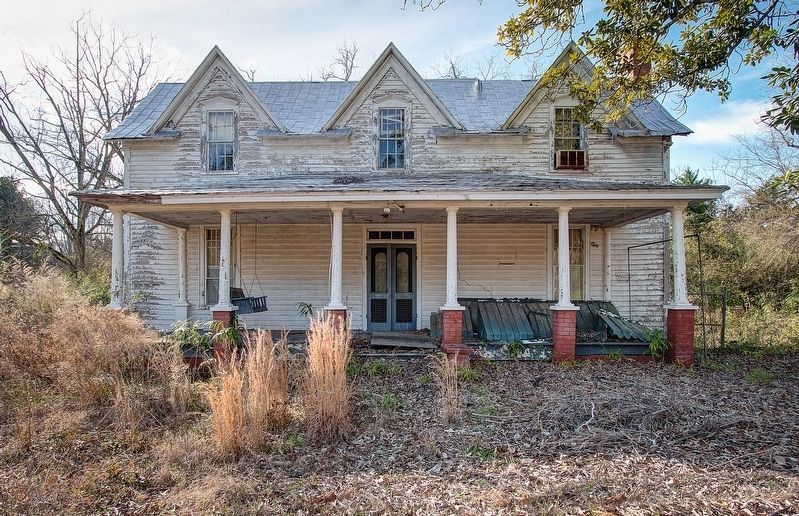Mt. Carmel in McCormick County, South Carolina — The American South (South Atlantic)
Mt. Carmel Historical District
Village of Remembrance
Mount Carmel, located on the northwestern portion of McCormick County, takes visitors on a trip back in time. The Mount Carmel Historic District is a picturesque example of a late 19th century village.
In the early 1880s Mount Carmel turned into a thriving village when the Savannah Valley Railroad passed through it. In February 1885, the town post office was established. Soon after, with the relocation of the Lodiment Reformed Presbyterian Church to town the population increased. An 1894 business directory of the town lists five general stores, a furniture store, druggist, confectionery shop, grocery, carriage maker, two blacksmiths, two gins, shoe shop, four physicians, two hotels, and seven churches. Most of the buildings in Mount Carmel were built during this period of rapid growth from the 1880s to the 1900s.
On July 30, 1896, a significant portion of the village was destroyed by fire. Four residences and twelve businesses were lost. Brick building quickly replaced the framed buildings that were destroyed. On August 4, 1906, the Town of Mount Carmel was incorporated. As time marched on, residents began to move toward more industrial areas in search of jobs. The arrival of the boll weevil in 1921 directly affected this highly rural location. The great depression of the 1930s dealt a final blow to what prosperity remained in Mount Carmel.
Today, Mt. Carmel is home to the oldest business in McCormick County, McAlister and Sons Furniture Store. Mt. Carmel is also the site of Fort Charlotte, now under water, the location where the first overt act of the Revolutionary War took place. Mount Carmel remains today as a reminder of McCormick County's past and hope for tomorrow.
Erected by South Carolina Heritage Corridor.
Topics and series. This historical marker is listed in these topic lists: Agriculture • Industry & Commerce • Railroads & Streetcars • Settlements & Settlers. In addition, it is included in the South Carolina Heritage Corridor series list. A significant historical month for this entry is February 1885.
Location. 34° 0.434′ N, 82° 30.4′ W. Marker is in Mt. Carmel, South Carolina, in McCormick County. Marker is at the intersection of Main Street (State Highway 81) and State Highway 95, on the right when traveling north on Main Street. Touch for map. Marker is in this post office area: Mount Carmel SC 29840, United States of America. Touch for directions.
Other nearby markers. At least 10 other markers are within 5 miles of this marker, measured as the crow flies. Fort Charlotte (about 500 feet away, measured in a direct line); Willington (approx. 3.3 miles away); Willington Academy (approx. 3.3 miles away); Cherry Hill / Noble Cemetery (approx. 3.3 miles away); Site of Willington Academy (approx. 3.9 miles away); Site of Willington Presbyterian Church (approx. 3.9 miles away); Capture of Fort Charlotte (approx. 4.2 miles away); Bobby Brown State Park Monument (approx. 4.9 miles away in Georgia); USS Scorpion (SS-278) (approx. 4.9 miles away in Georgia); Birthplace of Calhoun (approx. 4.9 miles away). Touch for a list and map of all markers in Mt. Carmel.
Also see . . .
1. Mount Carmel, South Carolina. Mount Carmel is a census-designated place (CDP) in McCormick County, South Carolina, United States. (Submitted on September 21, 2008, by Brian Scott of Anderson, South Carolina.)
2. Mt. Carmel Historic District. Mount Carmel is a small town that developed in the 1880s, contemporary with the development of the Savannah Valley Railroad. (Submitted on September 21, 2008, by Brian Scott of Anderson, South Carolina.)
Additional commentary.
1. Mount Carmel Historic District
Mount Carmel is a small town in rural northwestern McCormick County that developed in the 1880s, contemporary with the
development of the Savannah Valley Railroad. The community was a flourishing village by the turn of the century. Mount Carmel Historic District is located in the heart of the town and contains a high concentration of buildings constructed during the town's period of prosperity. Included in the district are residential, commercial, institutional, and industrial buildings, located in an irregular pattern adjacent to the railroad tracks. The district maintains integrity as a torn-of-the-century community; of the fifty-five properties contained in the boundaries, forty contribute to the historic character of the district. Several of the remaining buildings were also constructed around the turn of the century and have potential to contribute to the historic character and should be properly restored.
Properties Defining the Historic Character of the District
9. Baker's Store, ca. 1890. A one-story, weatherboarded commercial building with a gable roof. The facade features a central double door with an arched fanlight, flanked by large, round-arched windows covered by paneled shutters. A shed-roofed wing covered with corrugated metal has been attached to the right elevation.
15. John Cade House, ca. 1890. A two-story, frame residence with a hip roof and cross gables. A central pavilion features a gable emblazoned with the Masonic emblem. A one-story, hip-roofed porch has plain columns. A pent roof divides the first and second stories. Single-story, gabled wings on the side elevations have porches with chamfered posts, sawn brackets, and lattice balustrades. The chimneys have corbeled caps. Among the outbuildings are a blacksmith's forge and a doll house.
18. John W. Morrah House, 1896. A two-story, weatherboarded residence with a hip-and-gable roof. A one-story, hip-roofed porch has turned posts, a spool-and-spindle balustrade and frieze, sawn brackets, and a denticulated cornice. The chimneys have corbeled caps. Polygonal bays on the facade and right elevation have gables with small stained glass windows and wooden shingles in the gable ends. A small jerkinhead gable is set above the main, hipped roof. Among the outbuildings are a buggy house, pump house, saddle house, cook house, and doll house, all in excellent condition. The building was designed by architect Lewis F. Goodrich of Augusta, Georgia.
25. Mount Carmel ARP Church, ca. 1886. A frame meeting house with a gable roof. The facade has a central, recessed porch framed by a broad archway with sawn trim along the intrados of the arch. The central double door has a five-light transom and a pedimented architrave with console brackets. The building has corner pilasters and five pedimented windows with louvered shutters on each side. The rear has a polygonal chancel
with pedimented windows.
Significance
Mount Carmel Historic District is located in the village of Mount Carmel in rural northwestern McCormick County, South Carolina. The district contains forty properties, including residential, commercial, institutional, and industrial buildings, and is a good example of a turn-of-the-century trading village. Mount Carmel Historic District includes a collection of buildings which represent a range of late nineteenth and early twentieth century vernacular architectural modes. In addition, the village is significant in the history of the area as a commercial center.
Additional Information
References to Mount Carmel exists as early as 1836 in the journal of Mary Morgane. Mary's eldest sister was enrolled in an academy there, and she gives a lively account of the academy's May Day festivities at which she was a guest.[1] An advertisement in the Abbeville Banner of 11 November 1846 for Mount Carmel Academy's January term suggests that the school was in operation at least as late as 1847.[2} Local tradition holds that it was located on Caldwell Hill, and it is possible that an archaeological investigation of the area might prove fruitful.
Mount Carmel served the surrounding farmers as a trading center but remained a small, sleepy community until the 1880s. In 1885 a post office was established at Mount Carmel and by 1886 the Savannah Valley Railroad ran through the community. In this same period the Lodimont Associate Presbyterian Church moved to Mount Carmel and took the name of the town.[3] These three events apparently spurred development ad growth in the village. By 1894 there were five general merchandise stores, a furniture and vehicle store, a druggist, a confectionery, a grocery, a carriage maker, two blacksmiths, two gins, a show shop, four white churches, and three black churches. There were approximately 300 inhabitants.
In the summer of 1896 a portion of the town was destroyed by fire. The home of J.W. Morrah was burglarized and set afire. In the commotion, a lamp was overturned in Mrs. Burdett's store, triggering a second fire which destroyed approximately four residences and twelve businesses. J.L. Covin and J.W. Morrah rebuilt their homes on the sites of their destroyed residences (#10, #18). Several of the frame commercial buildings were replaced by brick stores (#17) constructed of materials made in D.B. Cades brickyard, once located on the site now occupied by Hester's gin (#47).[5]
The town was officially incorporated in 4 August 1906 with John L. Cade as its first intendant.[6] The years of prosperity Mount Carmel had seen just prior to the town of the century
began to wane not long thereafter. With the development of the automobile which reduced dependence on the railroad, residents began to move away to industrial centers in search of jobs. The boil weevil infestation of 1921 devastated Mount Carmel and the surrounding cotton producing areas. The final blow to the prosperity of the community was dealt by the depression of the 1930s.[7]
Today Mount Carmel is little changed from the early 1900s. Only two viable businesses remain and only two modern houses have been constructed within the district since that time. The population is 182; most residents live in new homes on the outskirts of the town limits.
Architecture: The history of Mount Carmel, during its period of greatest prosperity between 1885 and 1920, is effectively conveyed by the surviving buildings of the historic district. Over thirty buildings dating from that time frame define the district. The decline of the community from the 1920s and the relative absence of contemporary development have helped to preserve the integrity of the district from that period and to maintain the rustic sense of time and place. Most of the older buildings in the Mount Carmel Historic District are in relatively original condition.
The district comprises a body of vernacular frame buildings, residential, commercial, institutional, and industrial; the few key cultural buildings invoke some elements of high style. The John W. Morrah House (#18), the home of a wealthy and prominent family, was designed by architect Lewis F. Goodrich of Augusta, Georgia, incorporating the picturesque asymmetry, the multiple material textures, the polygonal bays, and the carpenter's ornamentation of the Queen Anne style. The Bank of Mount Carmel (#39) utilizes a Neoclassical metal cornice and masonry construction with simulated rustication in its brickwork to assert its importance. The old Baker's Store (#9) is distinguished by its temple form and by its elaborate arched doors and windows. The Mount Carmel A.R.P. Church (#25) has a distinctive recessed entrance porch beneath a broad arch with sawn decoration on its intrados.
The majority of the buildings in the district, residences of persons of modest income, follow the vernacular building modes that were common in the state through all its history. The single-pile, central-hall farmhouse is well represented in such buildings as the Miller-Horton-Bell House (#39), the J.L. Covin House (#10), and the Baker-Boyd House (#8). Other vernacular dwellings in the district include the Paschal-Patterson House (#28) and the Murray-Tarrant-White House (#27), which has a simple front porch of the bungalow mode. The Tenant House (#49) is a representative vernacular house of the lower-income citizens: a one-story, two-room, frame house with a central chimney, a simple front porch on the facade, and a shed-roofed rear addition.
Notes
1. Delle Mullen Craven, ed., The Neglected Thread: A Journal from the Calhoun Community (Columbia, S.C.: University of South Carolina Press, 1951), pp. 8, 11, 35-36.
2. Abbeville Banner (Abbeville, S.C.), 11 November 1846.
3. James A. Paulauskas, National Archives and Records Service, to John C. Blythe, Jr., 16 December 1980; Johnny McAllister, "French Huguenots Settled Mount Carmel and Bordeaux," The McCormick Messenger (McCormick, S.C.), 1 July 1976, p. 4C; Louise Ervin, "They Won't Give Up," Anderson Independent (Anderson, S.C.), 26 May 1976, p. 1D; The Press and Banner (Abbeville, S.C.), 24 February 1886, 5 August 1896; The Centennial of the Associate Reformed Presbyterian Church (Charleston, S.C.; Walker, Evans & Cogswell Co., 1905), p. 506-507.
4. "Mount Carmel," Press and Banner (Abbeville, S.C.), 22 August 1894.
5. The Press and Banner, 5 August 1896, 9 September 1896; McAllister, Dora Bryson, "History of the Town of Mount Carmel," 1970, typewritten.
6. Acts and Joint Resolutions of the General Assembly of the State of South Carolina Passed at the Regular Session of 1907 (Columbia, S.C.: Gonzales and Bryan, 1907), p. 857.
7. McAllister; Ervin; Karen Petit, "Town Fights to Live," Anderson Independent-Daily Mail (Anderson, S.C.), 9 April 1978.
— Submitted April 13, 2011, by Brian Scott of Anderson, South Carolina.
Credits. This page was last revised on September 17, 2020. It was originally submitted on September 21, 2008, by Brian Scott of Anderson, South Carolina. This page has been viewed 3,445 times since then and 177 times this year. Photos: 1. submitted on September 21, 2008, by Brian Scott of Anderson, South Carolina. 2. submitted on April 13, 2011, by Brian Scott of Anderson, South Carolina. 3, 4, 5, 6, 7. submitted on September 21, 2008, by Brian Scott of Anderson, South Carolina. 8, 9, 10, 11, 12, 13. submitted on April 13, 2011, by Brian Scott of Anderson, South Carolina. 14, 15. submitted on February 17, 2019, by Jodi Fialkowski of Lebanon, Tennessee.
